|
|
Post by codystarbuck on Sept 14, 2019 19:26:12 GMT -5
So, having completed my look at the cinematic James Bond, my eye now turns to those other cinematic spies and super agents, both those who preceded Bond and those he spawned (or at least created a climate for them to thrive). here we will meet such people as Harry Palmer, David Callan, Matt Helm, Derek Flint, Modesty Blaise, George Smiley, Joe Walker & Tom Rowland, Hubert Bonisseur de la Bath, Dick Malloy, Ken Stewart, and James Tont. We'll look at the more realistic (Le Carre's George Smiley), the spoofs (Matt Helm and Derek Flint) and the outright rip-offs (James Tont, Dick Malloy) and even the downright goofy. Along the way, we will take in spy-fi on tv, with classic shows like The Avengers, I Spy, Danger Man/Secret Agent, Mission: Impossible, The Man From Uncle, A Man Called Sloane, and the immortal Get Smart.
I plan on focusing on spy heroes, rather than spy conspiracies and thrillers, like The Thirty-Nine Steps, where innocents get caught up in espionage operations. That also rules out things like Fritz Lang's Ministry of Fear. I'm also skipping things like the serial heroes, like Spy Smasher (based on the comic book) and the more direct G-Men vs The Black Dragon and Secret Service in Darkest Africa. The latter two feature FBI agent Rex Bennett, battling foreign spies in America), then masquerading as a gestapo agent in Africa. These were more like detective/police thrillers, which is probably the real literary (and somewhat cinematic) antecedent of Bond.
In both fiction and film, one of Fleming's real influences was author Graham Greene. Greene was an Oxford grad, journalist and novelist, who was recruited into MI-6, through his sister, who worked for the department. his background made him ideal for gather intelligence and he turned some of his experiences into fiction. He wrote the afore-mentioned Ministry of fear, where an innocent man ends up receiving a cake, at a village fair, when he gets off a train to kill some time. It is a later novel that would be made into a satire, that we are interested in: Our Man in Havana.
Alec Guinness plays Wormold, who is recruited into MI-6, by a man named Hawthorne (Noel Coward). Wormold is a vacuum cleaner salesman, with a teenage daughter, who likes expensive things. He makes little money, selling vacuums, so welcomes the opportunity to make extra-money. However, he knows little of spying and ends up pulling things from newspapers and gossip, inventing a network of spies, using names of people he meets. He jazzes up his reports with sketches of a new installation in the mountains, derived from the vacuum cleaner parts. His reports are well received and he is sent help, in the form of a secretary and radio operator. The enemy soon believe he is a real threat and act against his network. His deception falls apart and he must admit the truth to the secretary (Maureen O'Hara). In the end, his bosses hide the reality and claim the installation was dismantled and he is given an OBE and a job teaching spies.
The original novel was a dark comedy, inspired by a German agent in Portugal, known as Garbo, who sent fictitious reports to his handlers, while claiming expenses that allowed him to live well. Greene took this and expanded upon the idea, shifting it to Havana, under Batista. The film ups the comedy and the film was shot in Cuba, with the blessings of the Castro government, though he complained that it undersold the brutality of the Batista regime (which was as bad as, if not worse, than Castro). Carol Reed directed, having already collaborated with Greene on The Third Man and Fallen Idol. The Third Man had shared many thematic and visual elements with spy thrillers (crime and espionage thrillers tend to follow similar structures), so the collaboration was perfect for this.
Guinness is the conniving "agent" and he had already built his rep on the Ealing comedies (Lavender Hill Mob, Kind Hearts and Coronets, Ladykillers, etc..) and is in good form, here. The cast is filled with great actors, including Noel Coward, Maureen O'Hara, Ralph Richardson and even Ernie Kovacs.
This isn't Bond; but, you can see similarities in things, if you look carefully. Both Greene and Fleming had been journalists and were recruited into intelligence work, though neither was a field agent. Fleming was more an administrator, though he was involved in planning of operations (though his plans and schemes were often impractical and ignored). Fleming worked for Naval intelligence, while Freene was with MI-6, dealing in counter-espionage, in Portugal and Spain (both neutral; but, both a hotbed of espionage and diplomatic activity, due to their neutral; but sympathetic status to the Axis powers). This is closer to being a real spy story than almost anything from Fleming and Bond, with more in common with John le Carre, another actual intelligence office, turned writer. Even more so with his novel, turned film, The Tailor of Panama.
This is a good one, even if you aren't a spy-fi fan. It precedes the spy craze, of the 60s, so we are spared the Bond knock off scenes and characters, which sets it well above much of what will be explore here.
Next, we turn to tv, for a look at what was one of the earliest spy series, predating Bond (in film, though not tv) with Danger Man, aka the Secret Agent. Here, we will look at Patrick mcGoohan and agent John Drake, a globetrotting agent of NATO, who may have learned a little too much, during his career, depending on your point of view.
|
|
|
|
Post by Deleted on Sept 14, 2019 19:34:36 GMT -5
Looking forward for this. I pretty much all the spy stuff in the 60's and on up.
|
|
|
|
Post by codystarbuck on Sept 15, 2019 21:12:31 GMT -5
Danger Man/Secret Agent
Before Bond hit cinemas and sparked a spy surplus, there were mostly novels and films that dabbled in things, like Our Man in Havana. In 1960, ITV was looking for series ideas that could be sold globally (a chief consideration to justify the expense of shooting with budgets and numbers of episodes that could be sold internationally) and spies seemed like an obvious choice. A spy series, about a NATO agent was commissioned, with Ian Fleming recruited to help develop the idea. Fleming added his ideas and moved on, while development continued, without him. The final idea was polished and a pilot episode, "A View From the Villa," was written by Brian Clemens (who would also create The Avengers). The episode took place in Italy and shooting was done at an odd little resort, in Wales, which had Mediterranean-style buildings. The episode launched secret agent John Drake into the public consciousness. ITV head Lew Grade found a buyer in CBS television, and the first series was broadcast in the US, as a summer replacement, for Wanted, Dead or Alive. However, they gave the title a bit of a tweak, to make the subject matter a little clearer....
The series was shown under its original title for that first season; but, CBS declined to help fund a second season and ITV couldn't continue the project. Then a funny thing happened. James Bond hit cinemas, in 1963 and spies were suddenly the fashion of the day. Danger Man was selling well internationally and ITV commissioned a second series. They were able to sell it to the US, who started using the Secret Agent name and replaced the opening titles and theme song with "Secret Agent Man," from Johnny Rivers. The lyrics would prove prophetic, with the line, "...giving you a number, and taking away your name."
In the second season, Drake is reassigned to working for British spy group M9. Well, metaphorically, as not mention is made of having worked for NATO. In the first season (US tv is in seasons, UK tv is in "series"; I will probably refer to either, but mean the same thing) he is an Irish-American, to help sell to the US; but, for the rest of the show's life, Drake is British and works for M9, a British department.
The show starred Irish-American actor Patrick McGoohan. McGoohan had appeared in the West End, to great acclaim and had small roles in British tv and film, including a miniscule part in the seminal British war movie, the Dam Busters, as a guard, outside a briefing room. Danger Man became his first starring role and his stamp was all over the part. The film was aimed at a family audience, something McGoohan championed, and Drake rarely used firearms. he did have gadgets, most of which were fairly practical and plausible, such as miniature cameras and tape recorders. Drake used his wits, and his ists, to get in and out of situations, rather than leaving a trail of dead bodies. he also didn't spend much time seducing the women in the series. he had a few romances; but, the series was rather chaste.
Drake was often at odds with his superiors and it wasn't uncommon for him to defy orders for a higher purpose. However, many stories had him making difficult choices, not always with happy endings. As a result, it was rather more mature than many of the other ITV adventure series. John Drake was a thinking man's spy and a bit of an idealist, which would help formulate the future for McGoohan and, perhaps, John Drake.
The series was shot in black and white, through series 3. Series 4 consisted of two color episodes: "Koroshi" and "Shinda Shima." They were later edited together and released as a feature film (as were episodes of The Saint).
Patrick McGoohan announced he was resigning from the series, where he would then join David Tomlin and George Makstein in creating a new series, called The Prisoner.
The Prisoner
(That sequence featured openings for the penultimate episode, "Once Upon a Time," and the final episode, "Fall Out," which was the only time that Portmeirion, the resort where exteriors of the Village were filmed, was identified)
The Prisoner had a bit of an odd birth.Towards the end of Series 3 of Danger man, McGoohan was looking to leave and had ideas for a new series he wanted to do. He met with ITV chairman Lew Grade and said he was resigning, after filming the proposed Series 4. Grade was unhappy that Danger Man wouldn't continue, so he asked McGoohan if he had other show ideas (per McGoohan) and McGoohan outlined the premise of The Prisoner. Grade made an oral agreement (despite not understanding the concept) to produce the new series, under McGoohan and Tomblin's new company, Everyman Films. McGoohan had spoken of some of the themes of the series in 1965 and there had been Danger Man episodes that contained some elements of what would become staples of The Prisoner. One DM episode, "Colony Three," featured an Eastern European school for spies, which was made to look like an English village, where the instructors were prisoners held there. John Drake infiltrates the school. He was also shown, in many episodes, to be unhappy with his masters' wishes and orders, and the whole Great Game of espionage. In some episodes he defied his orders, while others had him make hard choices that tore at his soul. These concepts and themes would form the center of The Prisoner.
George Markstein, who was a later story editor on DM, claimed to have created the idea, where John Drake resigns and is made a prisoner of a place where people who know too much are kept. it was based on his research of Inverlair Lodge, a resort where SOE agents were sent and kept incommunicado, temporarily, because they had been compromised or knew too much information of ongoing operations, until the danger of a leak was over. Markstein wrote the press guide for the series, outlining much of these ideas and helped write the series bible, for new writers. However, McGoohan's work and interview related to the ideas predate Markstein working on Danger Man.
The series begins as seen in the opening. Thunder crashes and a car is seen speeding down a road, where it pulls into an unknown building, somewhere in London, near Parliament. The man parks in an underground lot and walks deliberately to a set of doors that say "Way out." He barges into an office and delivers an envelope, with "By Hand" written on it. he paces and rages, the slams a fist downon the desk and envelope, cracking the saucer of the tea cup of the office inhabitant (implied to be the man's boss). The angry man departs in his Lotus kit car and is seen by some undertakers in a hearse. He passes them and hey seem to watch his progress. he stops at his flat and the hearse is seen at the curb, in the distance. As the man packs a suitcase, a mist comes through the keyhole and he collapses. He awakens in his room and then goes to the window and looks out, where he sees the Village.
This played out over the first episode, "Arrival," as the man goes out into the Village to figure out where he is. Telephones do not ring outside the Village and taxis are "Only local." He returns to his flat, where he receives a call to meet at Number 2, the Green Dome. He goes to the easily identifiable building, where he is met by a butler and taken to a high tech chamber, with a spherical chair, and a man who introduces himself as Number 2, the apparent head of The Village. the angry man asks who is Number One. Number 2 proceeds to discuss why the new man resigned his position and was leaving. The new man refuses to answer and responds to everything with increased ager. He is told that he is Number 6.
Throughout the series, Number 6 either attempts to escape the Village or thwart the plans of the ever changing Number 2. Each episode features a new Number 2, though actors Leo McKern and Colin Gordon both played Number 2 more than once (McKern in 3 episodes, including the finale, and Gordon in two). In the first episode, Number 6 finds a man he knows, Cobb (played by Paul Eddington). He talks to Cobb, who was also brought there and seems to be killed by Rover, the Village guardian (a blob that engulfs its prey). he later turns up alive, working for his "New Masters." Number 2 is changed during that first episode. Colin Gordon's Number 2 appears in two episodes, "A, B and C," where drugs and a mindtap are used to input scenarios into Number 6's mind, to try to determine why he resigned, with Number 2 believing he planned to defect. His other episode, "The General," featured a computer that flashed information into people's minds, as part of a new learning system, yet could not give them context for the data or promote original thought. McKern's Number 2 debuts in "The Chimes of Big Ben," where Number 6 helps a Russian agent escape, only to learn he never left the Village and the woman works with the Village. he returned in Once Upon a Time, where he was brought back to face Number 6 and demands "Degree Absolute," where he and Number 6 are locked in a chamber and Number 6 is systematically broken down to childhood, then pieced back together to recondition him and learn why he resigned. Number 6 turns the table on 2. 2 is brought out in the finale, as a witness, in the proceedings, where Number 6 is to be given his choice to leave or stay and lead the group, as well as meet Number 1.
The series, itself, was only draped in the world of espionage and intelligence work. it's real concept was the struggle of the individual and society at large. Episodes explored the right to think for oneself, to live outside the normal system, to not participate, or to just be different. Mixed in there were metaphors for Big brother surveillance, mind control, rote learning vs the Socratic method, satires of election politics, refusal to bear arms, creativity vs mass production and, above all,identity. We never really know if the Village is run by the East or the West, or a third power, unto itself. There are some theories that Number 6 is actually Number 1, head of the Village, testing it ("Who is Number One? "You are Number 6 or, "You are, Number 6"). I one episode, a rather sadistic Number 2 gets his comeuppance when Number 6 feeds his paranoia until he cracks, believing Number 6 is conspiring against him, with his masters, until Number 2 shows himself to be unfit and is removed, as payback for causing a young woman to jump to her death.
One episode, "The Girl Who Was Death," was actually an unused Danger Man script, which fuels some theories that Number 6 is John Drake. Markstein maintained that John Drake was The Prisoner, though McGoohan steadfastly maintained he was not and only "looked like him," winking at the idea that both were played by him. Legally, if the series was a continuation of Danger Man, creator Ralph Smart would be entitled to royalties. Many who worked on both shows felt it was a continuation, and actors were reused.
The series was shot at Portmeirion, in Wales. The complex was designed by architect Sir Clough Williams-Ellis, mixing different European styles. One of the central features was a life size chessboard, where games would be played with people as the pieces (which was also done in some Royal courts, across history). This was used in several episodes, particularly "Checkmate." The Village itself, was at some unknown location. In some episodes, it is said to be on an island, somewhere in the Baltic or the Mediterranean, in or near North Africa or Portugal. The finale shows Number 6 and Number 2 leaving the Village by truck and arriving, over land, in London, suggesting it is in England. In "Many Happy Returns, " Number 6 escapes the Village by sea nd ends up back in England, where he meets his superiors and leads an air search for the possible location of the Village, only to end up a prisoner, back in the Village.
The series was only 17 episodes, though McGoohan had only proposed 7. Lew Grade was against this and the idea was expanded to more, with 17 as the final number, when ratings and production difficulties brought an end to things. The series was shown in the US, though broadcast of the episode "Living in Harmony" was blocked. the stated reason was the depiction of the use of hallucinogenic drugs; but, the aired episode "A, B and C," included the same, as did "The Schizoid Man." Living in Harmony, which is done as a western, features the sheriff of Harmony resigning and giving up his gun and refusing to take it back. It was believed by ITV and McGoohan that the anti-War sentiment, during the height of the Vietnam War, was the true reason it was pulled, until the series was rerun.
The episode, "Do Not Forsake Me Oh My Darling," has Number 6's mind implanted in another body, with McGoohan only seen at the beginning and end. This was due to McGoohan being unavailable, while filming Ice Station Zebra (where he plays a British spy).
The broadcast of the final episode proved hugely controversial, as the ending is mostly left to the interpretation of the viewer. ITV's phones were swamped with angry calls, demanding to know if Number 6 escaped or not. The series answered few questions as it was more of a philosophical exercise, which expected the viewer to work it out for themselves. McGoohan stated it was a depiction of the struggle of the individual against the demands of society. It used symbolism to make points and suggest further questions and associations. the number badges worn by residents featured a pennyfarthing bicycle, which McGoohan said was an ironic symbol of progress, as it was both advanced and impractical, demonstrating that progress can be beneficial or detrimental, depending on point of view. The Village may not be either side of the Cold War and may be a power outside those ideologies and interests, suggesting things like the rise of conglomerates as global powers unto themselves. Some believe that the Village existed in another dimension and was run by a alien organization. The point was that it made people think and decide for themselves, which is what McGoohan wanted most of all. unfortunately, that isn't a popular circumstance for the majority of tv viewers, leaving The Prisoner as a cult series, with a rabid fanbase.
Danger Man/Secret Agent was adapted into a few comic books, from Western Publishing, with one issue of the Dell Four Color series, for Danger Man, and two issues of Secret Agent, under the Gold Key banner. The Prisoner was not adapted; but, a sequel was produced at DC Comics, by Dean Motter and Mark Askwith. There, a new agent resigns and finds her round the world sailing voyage diverted to The Village, where she meets Number 6, before the McKern Number 2 and the Butler turn up. Previously, Marvel had a license to adapt the Prisoner and first Gil Kane, then Jack Kirby worked on an aborted issue, adapting "Arrival." The series was not published, though a few art pages have been seen.
The Prisoner was optioned for film for many years, before it was redone for AMC and british television, with Ian McKellen as Number 2 and James CaViezel as Number 6. It was a rather bland attempt to modernize the thing, with plenty of New Age psycho-babble and boring scenes. McKellen was great; but, Caviezel had little to work with and hardly compared to the dynamic and forceful McGoohan. It was like replacing Orson Welles, in Citizen Kane, with Mr Rogers.
Next, another British spy series, though one that actually began as a detective series, starring a medical doctor, However, in the spirit of The Prisoner, you will have to figure it out for yourself.
|
|
|
|
Post by codystarbuck on Sept 15, 2019 21:25:29 GMT -5
Johnny Rivers' "Secret Agent Man," became a big hit and is played on classic rock stations, to this day and is a favorite for any spy music compilation. The Prisoner spawned it's own bit of rock legacy. Iron Maiden recorded two songs, "Back in the Village," and "The Prisoner," in tribute to the show.
The Prisoner has been homaged an satirized many times, though the best is still the Simpsons...
That's Patrick McGoohan voicing Number 6. It was also homaged in "The Joy of Sect."
(a little Live and Let Die homage, as well)
|
|
|
|
Post by codystarbuck on Sept 17, 2019 0:09:52 GMT -5
In 1960, the Associated British Corporation produced and aired a tv show, Police Surgeon, on the ITV network. The series starred Ian Hendry as Dr Geoffrey Brent, a GP and police surgeon, assisting with cases. 13 half-hour episodes were produced. Reception was mixed, but Hendry was praised. A new series was conceived around him, playing a new character, of the same profession. That character was Dr David Keel, a young surgeon and GP, whose fiance is murdered by a drug gang, in the pilot episode.  Keel receives a consignment of heroin, at his surgery, by accident and believe it is related to the gang and his fiance's murder. He comes across a mysterious man, who offers his help in bringing the killers to justice....  This tough, shadowy person is known as John Steed. The series was known as......... The Avengers!!!Each week, Dr Keel and John Steed investigate various crimes, with Keel's idealism often at odds with Steed's professionalism. Steed was the supporting character, at first, and wasn't even in the episode "The Girl on the Trapeze." Over time, though, his role increased and he handled the final episode of the series, on his own. The series was shot of video tape and was fairly studio bound, though some exteriors were shot later. Emphasis is more on crime and murder than espionage and counter-espionage, though some plots did get a bit more fanciful. A strike interrupted thing between the first and second series and Ian Hendry moved on to pursue a career in film (which didn't end up very well, despite an excellent turn in The Hill, with Sean Connery). Steed was moved up to the main character and Patrick MacNee was now the star. The second series had him team with several assistants. the first was another doctor, Martin King, who was basically a David Keel fill-in, using an unproduced script form the first series. King would only appear in three episodes (shot first but shown out of order). The second assistant was Nightclub singer Venus Smith, who appeared in 6 episodes. She was younger than Steed, more naive, though she was attracted to him. She did occasionally resent his intrusion into her life. It was the third assistant who became the most memorable: Dr Cathy Gale...  Dr Gale was an anthropologist, who grew up in Africa and whose husband was killed, during the Mau-Mau uprising, in Kenya. She was a tough, talented amateur, who often dressed in leather action clothes. Cathy Gale became the template for Steed's assistant, an amateur who would be in the thick of things. there was a sexual tension between Steed and Gale and she resided, temporarily, in Steed's flat (while he stayed at a hotel). together they faced a variety of threats, including a group of neo-Nazis, who sent messages via stamps, in The Mauritius Penny. The episode was written by Malcolm Hulke and Terence Dicks and they later ripped off their own plot to provide the debut episode plot for Tom Baker's Doctor Who ("Robot"). Again the series was shot on video and the stories were relatively serious thrillers, mixing crime and espionage plots. Cathy Gale would be in the thick of things, using her skills in judo against various thugs, while Steed got a bit of a sartorial makeover, replacing his trenchcoats with Saville Row suits, a bowler hat (with a hidden steel plate) and an umbrella, which hid a sword. Cathy occasionally carried small frame pistols, though she uses a rifle expertly in at least one episode. 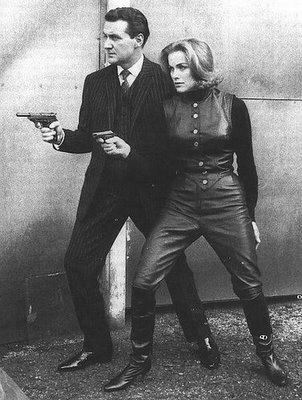 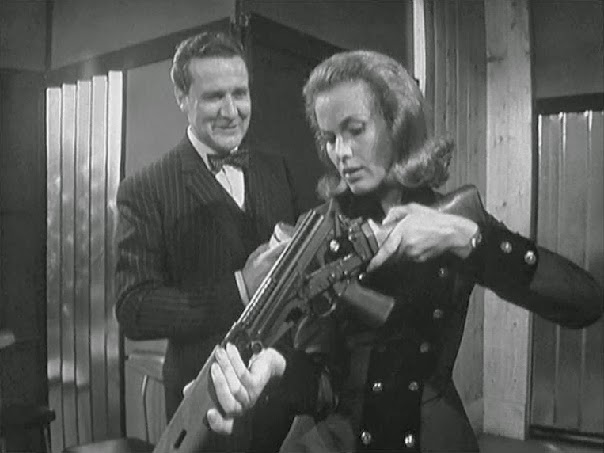  Cathy Gale stuck around for 2 series of episodes, and the show became a phenomena, in the UK, as a result. Her beauty, charm and whit were favorites of viewers, as was the charm and charisma of Patrick macNee, as Steed. Their playful and even combative banter livened up the show, even as plots remained serious. Cathy's leather suits added a fetish appeal, though they were introduced for practical reasons, as Honor Blackman split her trousers during a stunt scene and they decided tougher fabric was needed for action scenes, leading to the leather. Some of the outfits were designed by John Sutcliffe, who published the leather fetish magazine AtomAge. Blackman and MacNee even released a novelty record, "Kinky Boots." A movie version was in development when Honor Blackman landed the role of Pussy Galore, in Goldfinger, and had to bow out. The Avengers movie was shelved and a search went on for a new assistant for Steed. In 1965, ITV was able to sell the new series to a different ABC; the American broadcasting Corporation, for airing in prime time. This allowed the series to move from video tape to film, giving it a grander look and allowing for more exterior shooting. The producers wanted to open things up a bit and they lso wanted to amp up the sex appeal, or as they termed it, the "man appeal." As such, they wanted another female partner fr Steed. They found one in Elizabeth Shepherd, a young actress who had done some theater and television work. The character was, at first, named Samantha Peel, with the nickname "Mantha Peel." Thankfully, that was quickly scrapped and they played around with the abbreviation for "man appeal," "M Appeal," and came up with the name Emma Peel, and history was launched. For one and a half episodes. Looking at the footage, the producers weren't happy with Shepherd's performance and her look on screen and decided to change things. She was let go and they were back to searching for a new Emma Peel. The casting director persuaded the producers to look at a young actress, appearing in a tv drama. That actress was Diana Rigg, who had appeared in an episode of the series, The Sentimental Agent, that producer and chief writer Brian Clemens had written. She tested wonderfully with MacNee and they had their Ema Peel and the new incarnation of the Avengers was launched, not only in the UK; but in prime time, in the US.... Here, the show became legendary. Top professional John Steed and talented amateur Emma Peel take on a host of enemy spies, master criminals, psychotics, eccentric madmen, and other ne'er-do-wells, in a series that mixed action, drama, humor, and fantasy in liberal doses. the banter was even more playful between Steed and Peel, as they one-upped each other's witticisms, while kicking the crap out of the bad guys. Stunt arranger Ray Austin upped the fight scenes in the series and even introduced kung fu to the UK, via Emma's fighting style. At first, as with Honor Blackman, Diana Rigg did some basic judo throws and falls; but, was usually doubled by a stuntman (rather obviously, in some scenes). As things progressed, they lucked into finding stuntwoman Cyd Childs to double Rigg (and later Linda Thorson). In fact, Child can be clearly seen in the episode "The Living Dead (in Series 5, 1967), as she escapes from a cell by lighting a jailer in a fireman's carry and dumping him on his head. The stuntman was a bit heavier than expected and Child had trouble lifting and swinging him, which made her move slowly enough for her face to be captured by the camera. The series became a smash sensation on both sides of the pond, with the lighter fantasy tone blending well with the leads and with some brilliant scripts from Brian Clemens. The kinky element was amped up as Emma Peel was also given leather fighting suits and was often found in "restrictive" situations, such as "The Grave Diggers," where she finds herself tied to miniature railway track, with the train speeding toward her, while Steed battles their foe. However, once Emma got loose, look out! The episode "A Touch of Brimstone" featured a revived Hellfire Club, who were plotting to take down the government. Steed and Peel infiltrate it and the leader of the group (played by Peter Wyngarde), has Emma decked out as the "Queen of Sin." 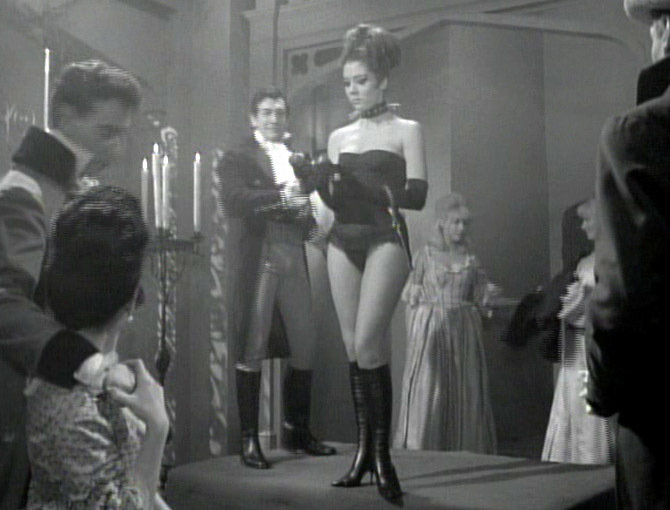 At the end of the episode, Emma defeats the Hellfire Clubs smaller fighter, then faces Peter Wyngarde, who is wielding a whip, but snags a torch, which triggers a trapdoor, dropping him down a shaft, to his presumed death. this episode would inspire Chris Claremont and John Byrne's homage in the X-Men, during the Dark Phoenix Saga. As time wore on, Diana Rigg pushed for a new wardrobe, as she hated the leather outfits and new action suits were designed for her (known as Emma Peelers), made out of a stretch fabric, crimpoline, while Steed also got a bit of updating, as the series moved to color, in 1967 (Series 5).    Alas, by that point, Diana Rigg was itching to move on. She had continued to work in theater, to great acclaim and received film offers. With Series 6, in 1968, she departed the series, appearing in the opening episode, "The Forget Me Knot," where she is taken prisoner and Steed must team up with a rookie agent, Tara King, to locate her. It is there we also meet Steed's boss, Mother, a rotund man in a wheel chair, who is assisted by the Amazonian Rhonda. Steed and Tara find Mrs Peel and free her, then word arrives that her long lost husband has turned up alive, in the Amazon. He returns to London and Mrs Peel says a tearful goodbye to Steed and leaves his flat. On the way out, she runs into Tara King and gives her advice on making tea for Steed. Steed watches from the window as Emma climbs into a car with a man in a smart suit and bowler hat, waves goodbye, then they depart. The series then progresses with young agent Tara King as Steed's assistant.  The sexual tensions and flirtations of Steed and Cathy Gale and Emma Peel turn into outright worship, in Tara King, as she is devoted to the older Steed. She lives in a younger person's flat, with an eclectic decor and often finds herself in more damsel situations than Emma.  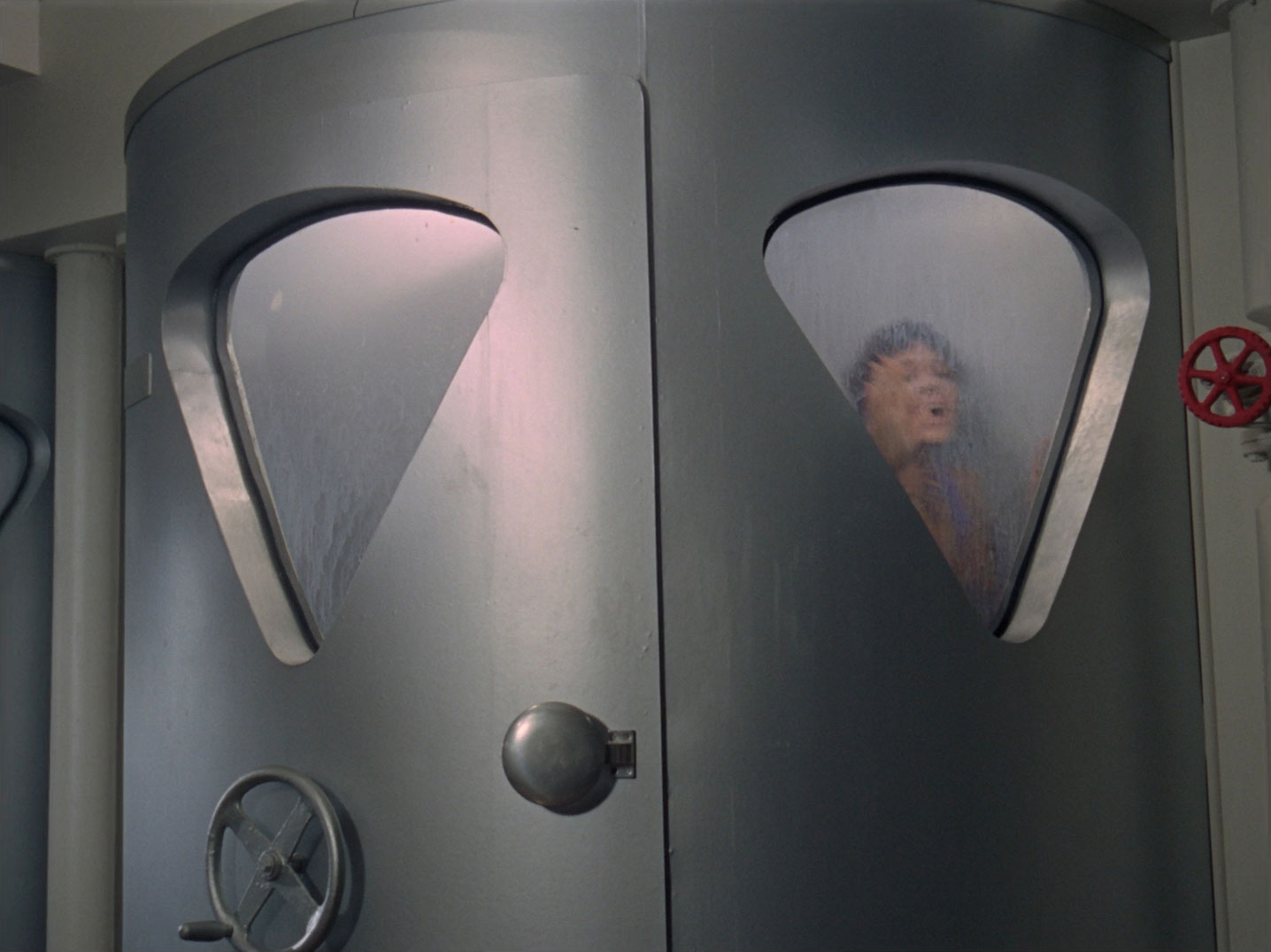 However, Tara is occasionally the rescuer of Steed, such as The Prisoner homage, "Wish You Were Here." Tara's wardrobe was a bit less stylish than Emma Peel's, as Thorson didn't quite have the same kind of figure. Originally, they wanted to have her be a blond; but, the bleaching caused her hair to fall out and she was forced to use a wig for a couple of early episodes. The episode "Have Gun, will Haggle" had been shot with her as a blond, but the footage was deemed unsuitable and the episode was mostly reshot, with some original footage left in. This necessitated Tara donning a blond wig, for some scenes, for continuity. The episode was also shot earlier on and it was felt that Thorson needed to lose some weight from her curvier figure. She did and looked smashing throughout her series, though some of the fashions used for her didn't always show her in her best light. Thorson was also a young actress and Canadian and had to work on her British accent. She considered Patrick MacNee to be a great friend and mentor who helped her through the rough early days and they remained close friends, even shooting a French commercial together, in later years.    In the US broadcasts, the Tara King episodes of the Avengers were shown against Rowan & Martin's Laugh-In and the Avengers were killed in the ratings. despite the success in the UK and Europe, the US failure hurt the series, financially and the production company already had financial problems and it was decided that the series couldn't continue, without US backing. Steed and Tara were last shown drinking champagne, as they were being rocketed into space, while Mother assured us they would be back. it would be many years; but, only Steed would be back, with a pair of new associates... Steed is joined by younger agents Mike Gambit and Purdey. Gareth Hunt played Gambit, the action man. he's a bit more ruthless than Steed; but not without his charm and he is the one flirting with Purdey, played by Joanna Lumley. Purdey was intended to mix Emma Peel's kick-ass action and sex appeal with Tara King's hero worship of Steed. Purdey was the breakout character and the most popular element of the series. Production was co-financed internationally and the first series is quite good, though it has some ups and downs and never rises to the level of the classic Emma Peel episodes. For the second series, production was moved to Canada, to appease investors and quality greatly suffered and there was no third series. 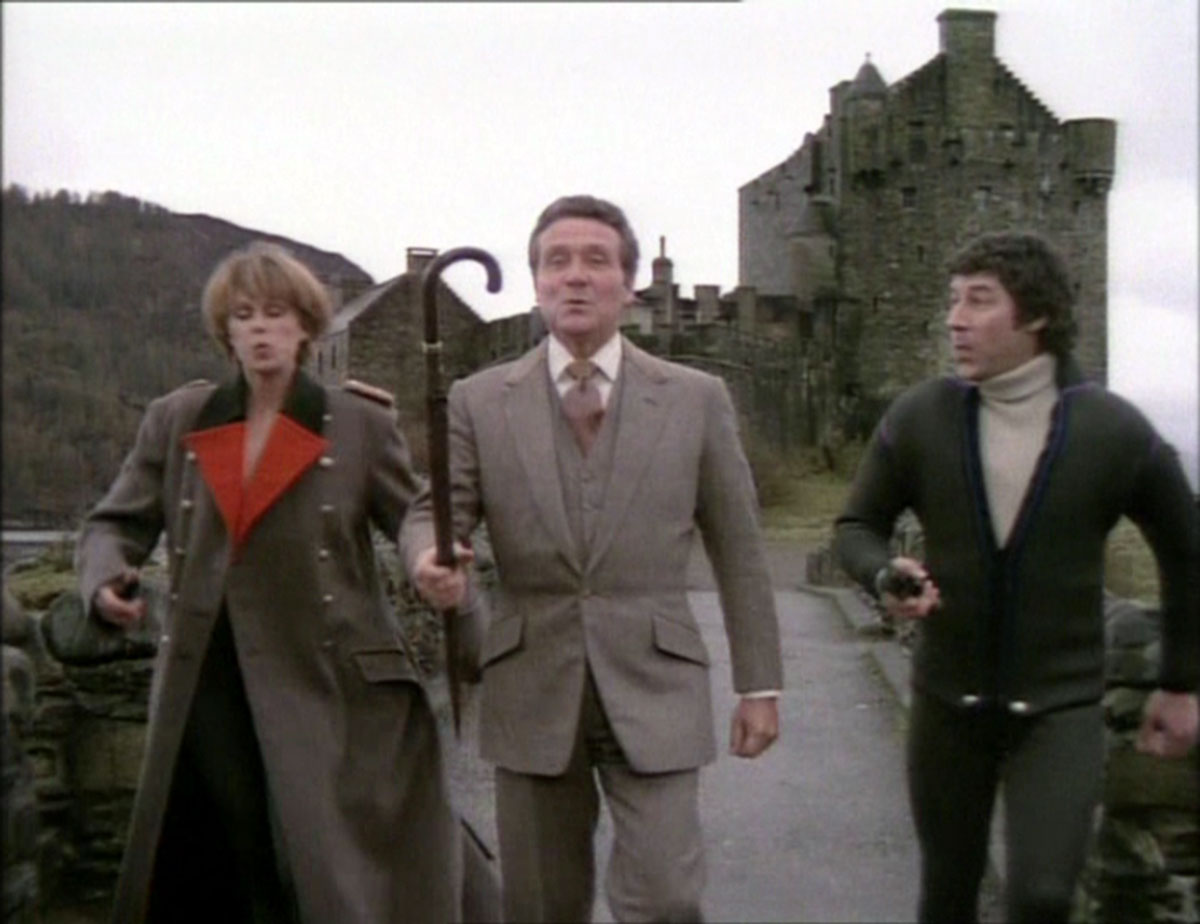 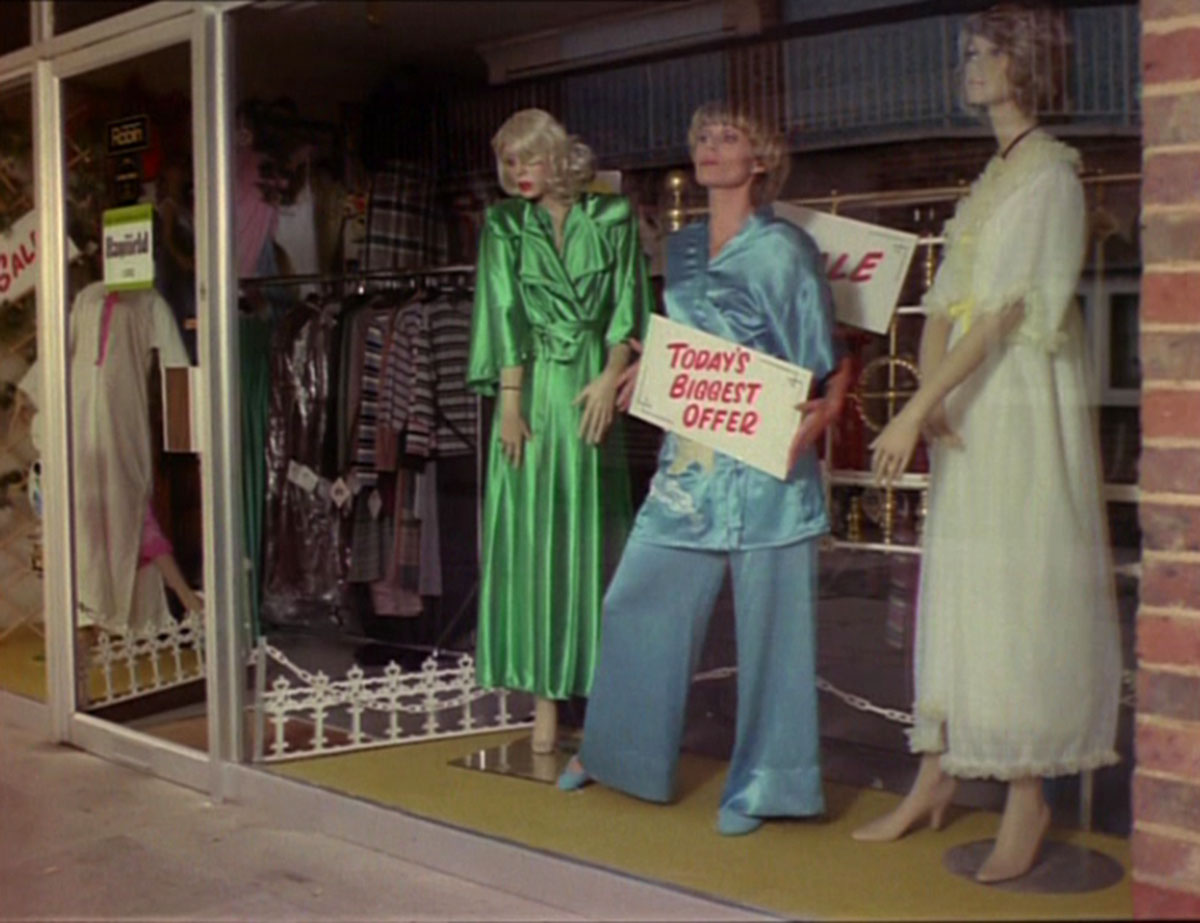 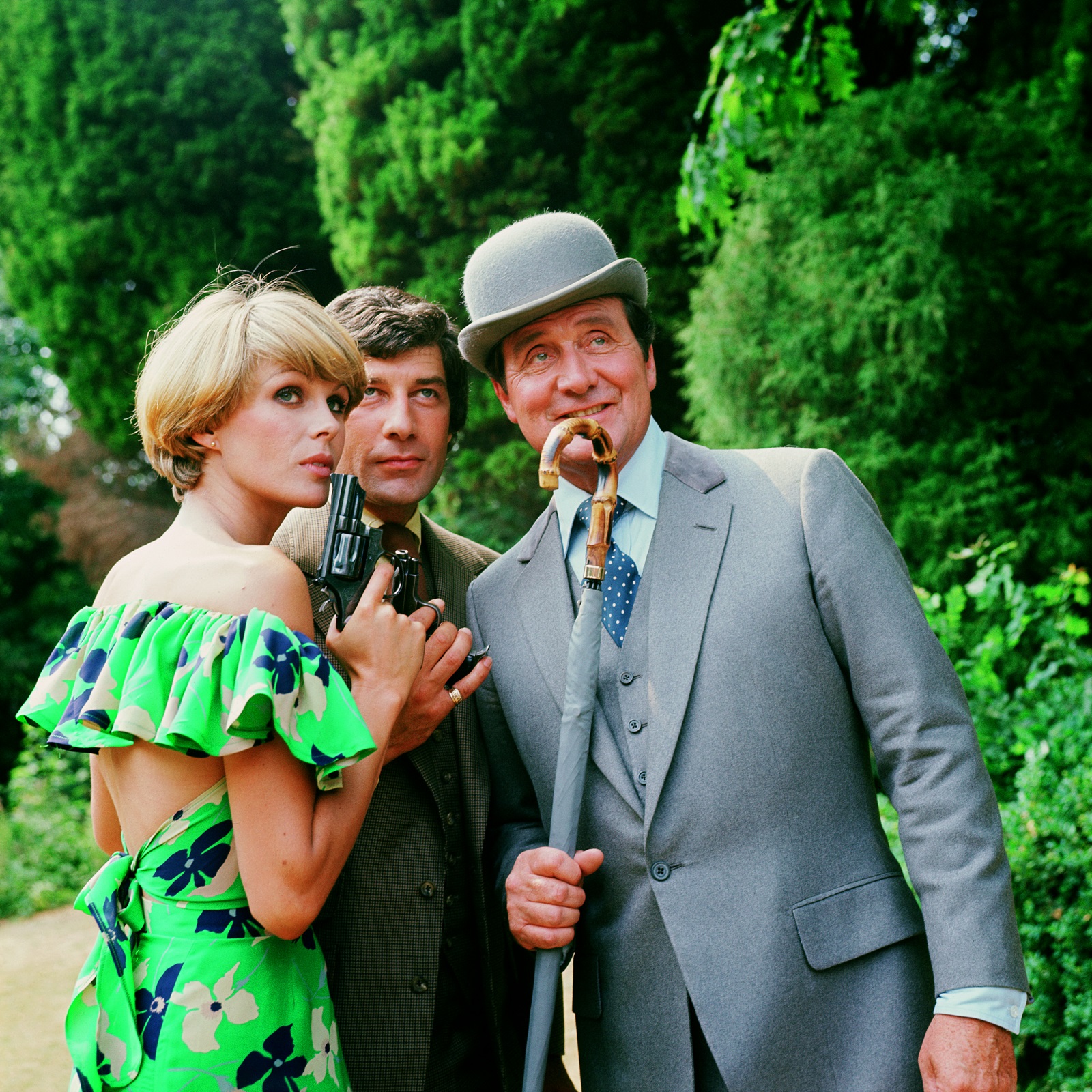 That would be it for Steed and his compatriots, for the next couple of decades. then came the advent of home video and the Avengers was released, somewhat haphazardly, on video, rekindling interest. The A&E Network, in the US, picked up the series, starting from the Cathy Gale episodes, which hadn't been seen in the US (the Emma Peel and tara King episodes had been seen on network tv and in syndication). This did much to revive Avengers fandom in the US and complete series releases of the Emma Peel and Tara King episodes followed, with Cathy Gale eventually getting released (the Ian Hendry years were mostly lost, with only two and a half episodes surviving being wiped for reuse of the tapes). The New Avengers had been seen on late night tv, on CBS, back when it first aired. It was not included in the A&E run; but, was eventually collected on dvd by A&E. A&E ended up being a source for several ITV shows on video and DVD, in the US, including Danger Man/Secret Agent, the Saint, The Prisoner, The Champions, and The Persuaders. Eventually, this revived popularity ed to a film version, the very first Avengers movie, with Sean Connery cast as the villain, Ralph Fiennes as Steed, and Uma Thurman as Emma Peel. It was.........sad. The charming whimsy and fantasy play of the original, with style and wit, was replaced by bad puns, stilted performances and more scene chewing from Connery than in Highlander. Thurman struggles with a bad accent, poorly scripted banter, and a fetish outfit that she can barely breathe in. Kill Bill it wasn't. Ralph Fiennes seems like he watched The Prisoner by mistake and thinks he is playing Number 6. Had this been the Prisoner, it would have been much better (provided it was Fiennes and Connery). Patrick MacNee has a "cameo," as an invisible agent (the result of an accident) which showed he was the smartest person in the production, as he escaped with dignity intact. Fans just shook their heads, went home and popped in an Emma Peel episode and nestled in for a warm evening of style and brain food, from a master and a Dame. F@#$ Marvel; there is only one Avengers! 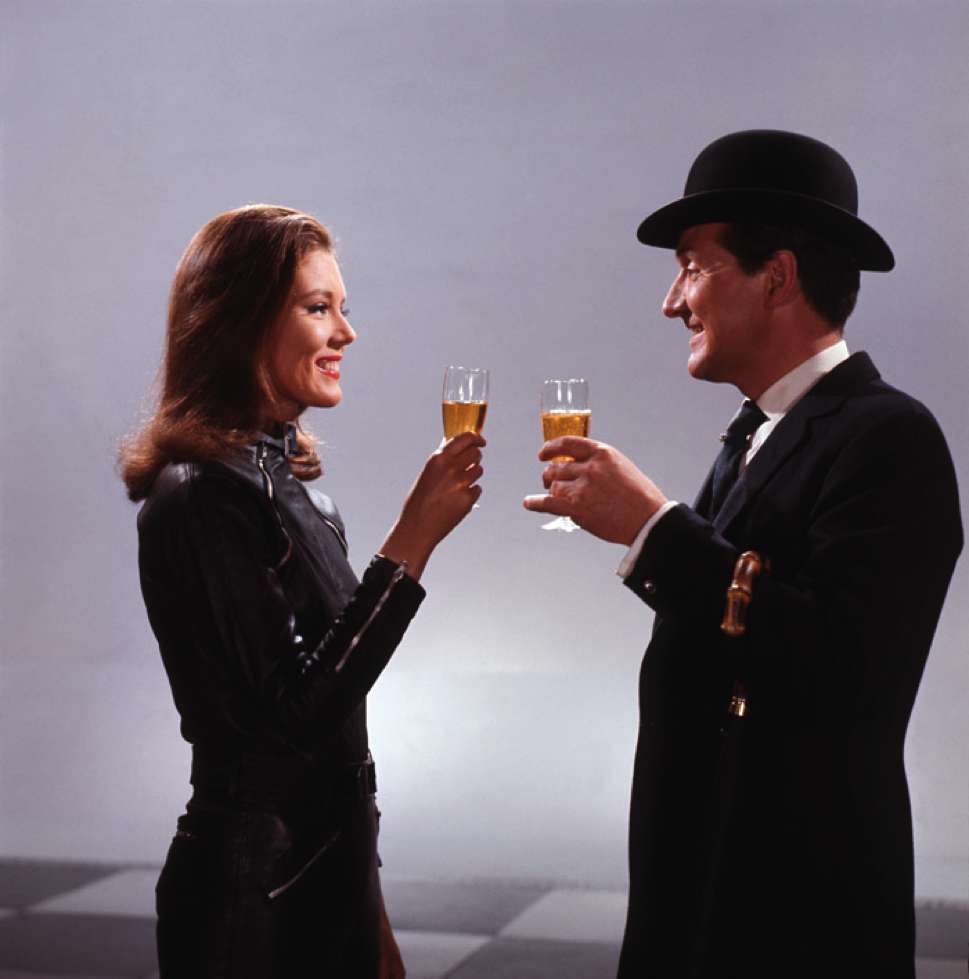 Next, Bond gets a rival, thanks to one of his producers. |
|
|
|
Post by codystarbuck on Sept 17, 2019 0:34:22 GMT -5
ps I discussed the Avengers connection with James Bond in that thread. Honor Blackman appeared n Goldfinger, as Pussy Galore, while Diana Rigg played Tracy, in On Her Majesty's Secret Service, and Joanna Lumley is one of Blofeld's angels, being treated for an allergy at his clinic, at Piz Gloria. 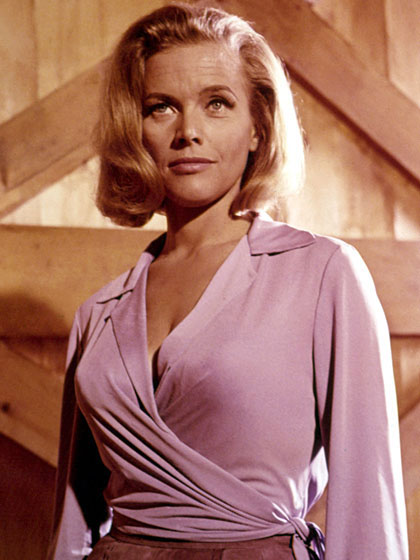  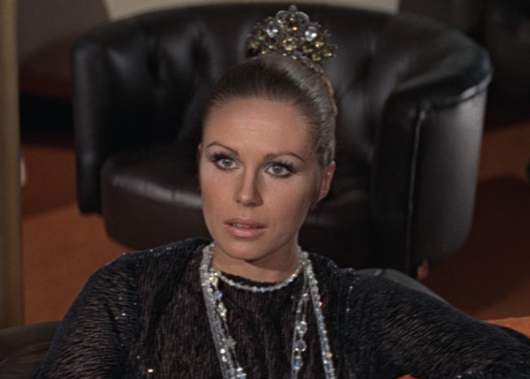 Patrick MacNee would join old friend Roger Moore in A View to a Kill..... 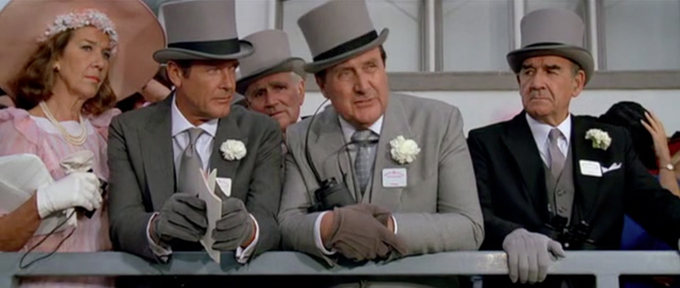 Patrick McGoohan never went near Bond and preferred the company of Lt Columbo. 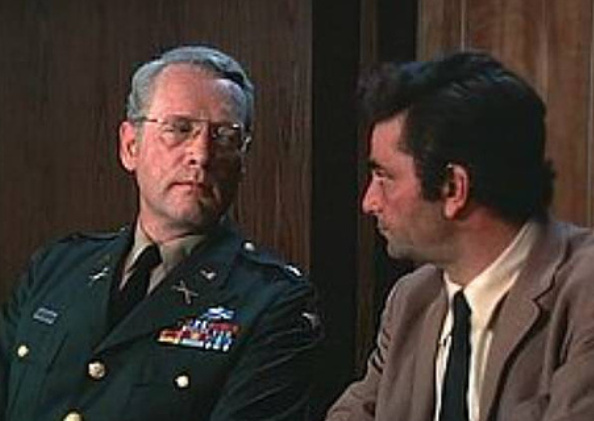 though he did play other spies, in film....  |
|
|
|
Post by codystarbuck on Sept 17, 2019 1:29:02 GMT -5
Here's the champagne ad that led to the New Avengers, minus Linda Thorson...
|
|
|
|
Post by Deleted on Sept 17, 2019 7:55:45 GMT -5
codystarbuck ... I watched the Avengers and the New Avengers faithfully every two weeks at my friend place and he and I along with our girlfriends watch 2 episodes together and play Bridge afterwards. I just watched the 13th Hole and that was a classic one indeed. We been doing this for two years together and this one of the most pleasant things that we do together. We have Dinner Together Watch 2 Episodes of the Avengers and New Avengers Play Bridge Have Dessert and go home afterwards
|
|
|
|
Post by brutalis on Sept 17, 2019 8:58:01 GMT -5
In the dictionary definition under Dapper it says see John Steed!!!
Same for Debonair, Dashing, Suave, Sophisticated, Stylish, Articulate, Gentleman, Elegant and various other appropriately designated terms and designations for one of the very best "spies" in her majesty's service.
|
|
|
|
Post by codystarbuck on Sept 18, 2019 18:47:55 GMT -5
So James Bond became a massive international hit. Everyone wanted in on the spy game. Some tried to copy the formula exactly, though with smaller budgets. Some tried to make fun of it. Some tried to differentiate themselves from Bond. so, how do you do an anti-Bond? Well, how about a near-sighted, working class spy, who wears drab mackintoshes, has to fill out paperwork for everything he does, and has to beg his boss for a raise? 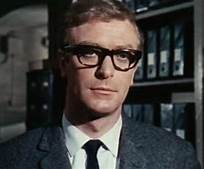 Enter Harry Palmer. Harry is an ex-serviceman, who was done up for black marketeering, and is basically working in the counter-intelligence and espionage game under duress. is boss is Col Ross, a Middle Class civil servant who seems to loathe Palmer, yet can't avoid the fact that he is good at what he does. Palmer is a gourmet cook, though it is hard to manage, on his meager salary. Harry Palmer had a bit of a strange birth. The series is based upon the spy novels of Len Deighton. Deighton had been an RAF aerial photographer, in Mosquitoes and Lancaster bombers, as well as with the Special Investigation Branch. After National Service, he went to the Royal College of Art and became a writer and illustrator, working for magazines and in publishing. He wrote history books, cookery articles, travel essays and fiction, and launched his first spy novel, The IPCRESS File, in 1962, with an unnamed protagonist, who is the narrator. At one point, someone says "Hello, Harry," to him and he remarks that his name isn't Harry; but, his line of work means remembering if it might have been, at some point. This initial novel deals with intrigue around a nuclear test site, in the South Pacific. All kinds of dirty deeds and doublecrosses ensue. The unnamed hero would return in Horse Under Water, A Funeral in Berlin and The Billion Dollar Brain. Two later novels, Spy Story and Twinkle, Twinkle Little Spy were credited and marketed as Palmer novels; but, it is unclear if it is the same narrator. The film series came about because of Bond. Harry Saltzman and Cubby Broccoli contacted Len deighton about writing the script for From Russia With Love. Little of his script made it into the final draft; but, Saltzman saw deighton's own spy novels as the basis for a potential second series. he optioned the books and brought in a lot of the Eon collaborators, like designer Ken Adam , editor Peter Hunt, and composer John barry to work on the first film. However, he wanted it to be different than Bond. Saltzman had produced several of the "kitchen sink dramas,' which had gained acclaim for british film, such as Look Back in Anger and Saturday Night and Sunday Morning. He wanted something more low key, more realistic than Bond and the style of those social dramas helped form the approach they would take with adapting The IPCRESS File. Michael Caine had received good notices for Zulu, though wasn't yet quite a superstar. he signed on to play the unnamed spy and remarked how the name Harry Palmer came about. There was a discussion in Harry Saltzman's office, when they were trying to come up with a bland name. Saltzman asked what the most drab name was and Caine replied, "Harry." Saltzman glared a minute and said, "Thank you, very much." They were then looking for a surname when Caine suggested Palmer, after Tommy Palmer, the most boring person in his class (or so he tells it). Thus, our spy became Harry Palmer and the series began with The IPCRESS File... In the film, Harry Palmer is working for Col Ross, in the Ministry of Defense. A scientist named Radcliffe has disappeared from a train, with his security escort murdered. 16 other scientists have also disappeared. Palmer is seconded to Maj. Dalby, who leads the section that provided the security detail. Dalby introduces Palmer and briefs his team. Their suspect is Eric Grantby and they are to locate him and report in. Palmer sees this as a waste of time and uses a Special Branch contact to find Grantby and makes an approach. He is attacked by Grantby's bodyguard, code-name Housemartin. Dalby chews out Palmer, but goes with what he has learned and they try to follow up. They are able to arrest Housemartin and Palmer and a colleague go to collect him from the police and find him dead, after Mr Palmer and Carswell visited him. Evidence leads Palmer to suspect Radcliffe is being held at a disused factory and he fakes a high authorization for an assault, which yields nothing, except a fragment of audio tape, with IPCRESS stamped on it. The tape plays nonsensical sounds and nothing more. A note passed by Grantby was written on a band performance brochure and Dalby meets with Grantby, at a concert. They broker a deal for the return of Radcliffe and the exchange comes off, though Harry inadvertently shoots a CIA man. However, Radcliffe breaks down while trying to deliver a guest lecture. Someone has messed with his head, causing a nervous breakdown when he tries to discuss his specialty. Carswell discovers a book, titled Induction of Psychoneuroses by Conditioned Reflex, Under Str ESS. He goes to follow up, borrowing Harry's car and is shot dead. Harry believes he is the target and heads home to gather some things and finds another CIA man dead in his place. he returns to the office and finds the IPCRESS File missing. he informs Dalby of Ross' instructions to microfilm it and suspects Ross of trying to kill him. Dalby tells him to get out of town for a while, while he goes after Ross. Harry is kidnapped from a train to Paris and wakes up a prisoner in Albania. he is subjected to extreme cold and noxius food, while he is broken down. He is then subjected to stress-inducing noises and lights, while Grantby tries to condition him. Harry has secreted a piece of wire from his edspring and digs it into his hand to create pain, to focus upon, beating the conditioning. he escapes and discovers that he is actually in a warehouse, in London. he contacts Dalby, who uses the trigger words to command Palmer into calling Ross to meet him at the warehouse. Ross turns up and Dalby attempts to set up his death, with a partially brainwashed Palmer caught in the middle. The film is directed by Sidney Furie (Leather Boys, Boys in Company C, Iron Eagle), who fills it with a sort of low key style, with dutch angles and interesting shots of often banal moments. Palmer's world is drab and filled with paperwork and bureaucracy. Dalby's organization is in a dingy suite of rooms, at a photo processing place, with dusty shelves, old furniture and a chainsmoking secretary (Alice, who is a constant in the series, along with Guy Doleman, as Ross). The cast is terrific, with Caine, Sue Lloyd, Nigel Greene, Gy Doleman, Gordon Jackson, and Frank Gatliff. There is a terrific scene where Sue Lloyd turns up in Harry's flat, holding his unregistered Beretta pistol. Harry proceeds to impress her with professional cooking skills (with Len deighton providing the hands, as he expertly cracks eggs and whips up a souffle. Let's see Bond seduce a woman with cooking skills! Throughout the film you are never sure who to trust, as Ross sends Palmer to spy on Dalby, Sue Lloyd is working for Dalby, yet turns out to be Ross' inside "man," and Palmer suspects Ross of being behind things, when Dalby is the turncoat. Even the torture in Albania isn't real. This is a spy series for the mind, which is part of its charm and part of what elevates it over most 60s spy movies. It deals in more realistic intelligence and counter-intelligence work (Dalby's group are counter-intelligence people, which would be the job of MI-5), without all of the glitz and glamor and much more of the paperwork and frustrating rules. Palmer even has to sign a chit for a .32 cal Colt revolver, forced on him by Dalby, over his Beretta. Bond never had to sign a receipt. The look of the film is so drab you'd swear it was in black & white (which is how I originally saw it, on tv). The film did well and it and Alfie (the following year) made Caine into a bona fide superstar. Soa sequel was inevitable. Harry is back working for Ross and he is sent to Berlin to meet with Soviet Col Stok, a top KGB man, involved in counter-espionage. Harry's contact is Johnny Vulkan, an old criminal associate, from his black market days. Harry meets Stok, who demands to be taken out by Otto Kreutzmann, a criminal who helps people escape from East Berlin, for a very large fee. Stok wants the best. Vulkan helps Palmer arrange it. Harry reports back to Ross that Stok is genuine, though he believes a model that Vulkan introduced him to is a spy. Ross sends Palmer to a little man to get the documents that will be used to help get Stok out. Back in Berlin, Palmer meets Samantha, the model again, who admits to working for the MOSSAD, who are searching for Paul Louis Broum, a camp guard who stole a million in gold. Kreutzmann supervises the operation to bring Stok over and Harry waits with his accomplice. The colonel is being smuggled out in a coffin and when it arrives and is opened, they find the dead body of Kreutzmann. Vulkan knocks Harry out and takes the documents, when Samantha and the MOSSAD turn up and take him away. Harry tells Ross what happened and Ross reveals that Vulkan is Broum, who murdered the real Vulkan and took his place. Ross had used the documents to blackmail Broum/Vulkan into working for him. he tasks Palmer with killing Broum. The climax deals with a series of double crosses and a bit of justice. The film was shot extensively in West Berlin, which was undergoing the German Economic Miracle. The film highlights the prosperous West with the crumbling East and begins with an exciting escape of a concert pianist from east Berlin (Kreutzmann's work). We get to see German nightclubs (including one that features drag performers and staff), as well as dingy buildings. The cast is, again, filled with great character actors, including Oskar Homolka, as the delightful Col Stok, Paul Hubschmid as Vulkan, Eva Renzi as Samantha, Hugh Burden as Hallam (the man with the documents), and unter Meisner (Slugworth, in Willy Wonka) as Kreutzmann. Double dealing is again a major part of things, as Stok uses Palmer to root out Kreutzmann's network and get rid of Vulkan, a fascist enemy of his people, as well as Harry's. Ross knew who Vulkan was and uses the situation to root out a mole in his organization. The Israelis use Harry to get their hands on the documents needed to get the Holocaust Gold back, to aid Israel in its fight for survival (in the 60s, anyway). Only Harry is what he seems, though even Strok proves to be the closest thing he has to a friend, as they understand each other's motivations. Stok even gives Harry an offer to join the East, if he ever grows tired of the hypocrisy of Ross' games. Stok is a true patriot, as is Harry, which is part of why they understand each other so well. The film is a bit uneven and it gets confusing at points, which hurts the flow, compared to the IPCRESS File, which builds from start to finish. As such, the film is usually rated lower than IPCRESS, though I quite enjoy it (and believe I actually saw it first, as a weekend movie, in syndication). It certainly has more of an international scope, to compete with Bond, compared to IPCRESS, which feels more like a bigger budget Avengers episode (or Danger Man, or even The Prisoner, seeing as Guy Dolema was the first Number 2). A third film in the series would follow.... Harry has left Ross' employ and works (barely) as a private investigator. Ross visits him to try to recruit him back, but Harry declines. He then receives a delivery of plane tickets and money, then a phone call, with a mechanical voice, telling him to retrieve a package and deliver it to Helsinki. He takes the package to a shoe store and uses a fluoroscope to reveal it contains eggs. In Helsinki, he meets his contact,a woman named Anya, who takes him to her boss, Leo Newbigen, an old friend of Harry's. It was Leo who suggested Harry to his boss. He wines and dines Harry, who notices that Anya is faking her affection for Leo. The next day, Leo introduces Harry to their boss. he takes him to a sterile and mostly empty room, with a desk and an audio speaker, as the boss is a computer, which hands out assignments. Harry is forcibly recruited by Ross, because the package contained stolen bio-warfare viruses. Harry is ordered to Latvia, to make contact with a resistance group, which turns out to be a small group of misfits. he is captured, then released by Col Stok, who suggests he is working for the wrong people. In Helsinki, Anya tries to seduce, then kill harry, but he stops her. he confronts Leo and blackmails him into giving him half of what Leo is being paid. They travel to Texas and meet the real boss, Gen. Midwinter, an oil baron and John Bircher fascist. he plans to launch an invasion of Latvia, in support of an uprising, and bring about the fall of Communism, in the Soviet Union. Harry recognizes he is completely nuts and Leo covers up his own double dealings, s he has bluffed Midwinter into believing he has a massive network of agents, while he pockets the money to fund them. he feeds false orders into Gen Midwinters massive computer center, which delivers orders to his agents and steals the virus laden eggs. Harry remains alive by convincing Midwinter he knows where Leo is going and can get the viruses back. he goes back to Helsinki with two minders, who are shot and killed by Anya. She takes the eggs and shoves Leo off a train. Leo and Harry work to try to stop Midwinter's private army, who are using oil trucks as personnel and rocket carriers, driving across the frozen Baltic Sea. Col Stok orders bombers to bomb the path in front of the convoy and it plunges into the icy waters, drowning and killing Midwinter and his army. Only Harry survives, where he is met by Stok and Anya, who is his agent. The film was directed by controversial director Ken Russell, who had mostly been working in television. Caine introduced him to Saltzman. Russell wanted to do a film about Nijinsky and Saltzman was interested, and suggested directing this film as a way to keep his hand in, while a script was developed. Caine later regretted getting Russell involved, as he was not the right person for directing a complicated thriller like this. Russell's specialty was emotional drama and avant garde scenes, rather than sharp narrative and intricate plot. he crafts some of the most striking imagery; but, the plot is all over the place and it gets very confusing, and the pace is rather stop and go. Again, there is a terrific cast, with Karl Malden as Leo, Francoise Dorleac as Anya, Oskar Homolko back as Strok, and Milo Sperber as the leader of the Latvian group. Midwinter is played, with gusto, by character actor Ed Begley Sr (Ed Jr must favor his mother), who makes him a real Bircher, complete with his own Texas Nazi rally and a logo that looks like a reworked swastika (complete with Nazi eagle wings....)  The Brain computer was filmed at the Honeywell facilities, plus a soundstage and designs by Syd Cain. It looks amazing, especially in the days when it took a roomful of computer equipment to do what a desktop can do know, let alone a smartphone or tablet. It's a cathedral of magnetic tape and punch cards, with multiple levels, security barriers, and a steel door that descends from above. A young Donald Sutherland can be seen as a technician in the complex and he also provided the voice that gives Harry his orders. The Canadian Sutherland was working in the UK for much of the 60s, appearing in films and television shot in the country. He can also be seen in an Avengers episode, "The Superlative Seven." The film fared poorly at the box office and spelled the end of the series. deighton would publish more spy novels, thrillers, and history; but Harry was retired, on screen. Until 1995, when Harry was revived for a pair of made-for-able movies, Bullet to Beijing and Midnight in St Petersburg. The first sees Harry once again resign, permanently, from government service and he goes to work for a former intelligence officer, who runs a private company. He is hired to retrieve a stolen binary weapon. He is aided by a young agent of Alex's, a man named Nicoli, who turns out to be Harry's son, played by Jason Connery (son of Sean). Michael Sarazin plays an ex-CIA man and friend of Harry's also involved. The plot revolves around a train and North Korea and gets into the world of the post-Soviet oligarchs. It also takes advantage of the opportunity to film in St Petersburg. Mia Sara (wife of Connery) plays the daughter of Alex, who is mixed up in things. A second film followed (Midnight in St Petersburg,) where Harry hunts for stolen plutonium. The two films were shot back to back and also feature Michael Gambon, as Alex, Burt Kwouk, as the North Korean intel officer, and Sue Lloyd, making a cameo, in Bullet. Jason Connery had already dabbled in his father's work, playing Ian Fleming in the ridiculously fictional Spymaker: The Secret Life of Ian Fleming, which concocted a fantasy bio of Fleming and origins for his Bond plots and characters. About all it got right was that Fleming worked for Naval Intelligence (as an administrator), that a commando team worked for his section (though he did not lead it), and that, as a journalist, he covered a show trial in the USSR. Pretty much everything else was BS. Connery got his start as a replacement Robin Hood for the series Robin of Sherwood, after Michael Praed left. In both endeavors, he is rather wooden. he is better here, though still somewhat inexperienced. He was much better by the time he appeared in Smallville. And, that was Harry Palmer, though there are rumors of remakes. Caine's image as Harry Palmer was iconic and has been alluded to in the Austin Powers series (which inspired the glasses and led to Caine being cast as Austin's father), as well as the Kingsman films (both with the glasses and with Caine as one of the old guard Kingsmen. If you have never seen them, I highly recommend The IPCRESS File, as it is a terrific spy thriller and a great film. Funeral in Berlin is a pretty good spy movie, with some wonky bits in the late middle and tail end, but great characters and scenery. Billion Dollar Brain is more of an arthouse spy adventure and should be approached accordingly. It has some great scenes and a terrific cast; but, don't expect a fast pace or logical plot. In the US, the series distribution rights were held by different companies, leading to problems obtaining them. The IPCRESS File was distributed by Anchor Bay, which went out of business, taking the dvd out of print. There is an Australian Blu-Ray, that is Region Free. Funeral in Berlin was put out by Paramount, in VHS and DVD, then taken out of print. It was later made available as a manufacture-on-demand title. Billion Dollar Brain was through MGM and was made available on DVD, at bargain prices. Funeral is available for digital rent on Amazon prime and all three movies are available for sale, though at higher prices, in some cases. I have a Region Free disc of IPCRESS, from South Korea, a manufacture-on-demand of Funeral, and the commercial release of Billion Dollar. I had the commercial VHS for the first two, then a spanish subtitled one for Billion Dollar, before the dvd came out. In the UK, there was a complete set of all three films. The two cable sequels were once available on dvd, in the US, for low prices. Don't know about now. Next time, it's time to delve into some of the spy satires that followed Bond, as we will first look at one Derek Flint. |
|
|
|
Post by codystarbuck on Sept 19, 2019 16:16:14 GMT -5
Next up is one of the first Bond satires, in the form of superspy Derek Flint. 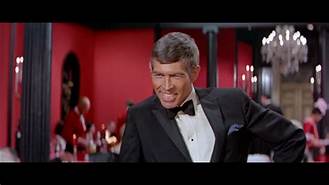 Starring James Coburn, Lee J Cobb, Edward Mulhare, Gila Golan, Benson Fong. A group called Galaxy, led by three scientists who are fed up with the world's leaders inability to solve its problems, have threatened to unleash natural disasters unless power is turned over to them. Kramden, head of the Zonal Organization for World Intelligence and Espionage ( ZOWIE) is tasked with stopping them. The computers select one man, Derek Flint. Cramden is against it; he;s too undisciplined, won't take orders. The bosses are unfazed and Cramden goes, hat in hand to recruit Flint. Flint, a polymath, great at everything, and refuses. He goes off to dinner with his 5 beauties when a Galaxy agent, Gila, tries to kill him with a dart, dipped in poison, saving Cramden's life. Flint takes the job and traces the dart to Marseilles, where he fights Hans Gruber, a Galaxy killer. Gruber had a jar of cold cream that points to an Italian firm, and Flint tracks it and meets Gila. he breaks into Galaxy's safe and learns the location of their island. he fakes his own death, after learning that his assistants have been kidnapped. He sneaks onto the island and replaces a guard, but is discovered by a bald eagle, trained to attack Americans. The scientists try to recruit Flint; but, he refuses. Gila turns babyface (she has been disgraced anyway) and slips Flint his lighter, which he uses to boobytrap Galaxy's disintegration machine. he gets his assistants and Gila out in barrels and sabotages Galaxy's machinery, after killing Rodney, Gila's former assistant. Flint does a swan dive off a cliff and swims to a nearby naval vessel, where he is reunited with Cramden and the ladies, while LBJ thanks him via phone. Our Man Flint is a tremendously fun film, that neither takes itself too seriously nor gets too hokey. It has plenty of action to keep you interested, a ton of sex appeal, but is light enough to make it playful, yet smart. Flint is less a James Bond than a Doc Savage, expert at everything, physical marvel, surrounded by his assistants (except Flint is more heteresexual than Doc, who was rather repressed). When Cramden offers a Walther PPK and briefcase of weapons to Flint, he rebuts with a lighter than can perform 83 functions (84, if you want to light a cigarette). He has a German Shepherd receptionist that takes visitors by hand (in jaw) and leads them to Flint; but, won't release them until they smile and reveal peaceful intent. Cramden rants and raves and huffs, yet recognizes that Flint is a genius and the most capable man. he just can't control him, which drives him nuts. Coburn established himself as a leading man in this film and is charming and tough, doing his own fight scenes, making use of his martial arts training with Bruce Lee. He also delivers some of the goofiest lines with pure conviction, which helps sell them. He utters one of my favorite lines in movies; "An anti-American eagle; that's diabolical!" They have fun with perceptions, as the three scientists are all ethnic types, with the names mixed up. The Asian , played by Benson Fong, is Dr Schneider, while the Germanic is Dr Wu. Flint meets up with british agent 0008, who gets his butt kicked, in the Marseilles bar. Flint's genius borders on the ridiculous. He tastes bouillabaisse on the dart that hits Cramden and is able to trace it to a district in Marseilles, due to the proportion of spices. There is a scene where he stops in one restaurant, has one taste, gets up and leves, before arriving at the bar where Gruber is eating. Galaxy's Island is a pleasure Eden, where agents get to have fun with "pleasure units," to which Flint's assistants have been conditioned and Gila is sentenced, for her failure. Flint breaks the conditioning; but, we see the ladies in different fantasy scenarios (Roman orgy, back seat of a car at a drive-in, dance club. It even gets a bit kinky as Gila demonstrates the branding of the women, so that they can infiltrate. That's messed up! Flint gets the ladies out by sealing them in empty cosmetic barrels and sending them over a waterfall, into the sea. They are picked up by the Navy and helped out of the barrels, where you can see one of the extras cup Gila Golan's breasts, as he lifts her out. Seriously, the guy copped a feel in a movie take! The film did big business and a sequel followed. A space platform has been launched and Cramden and the President celebrate, with a round of golf. the president is kidnapped and a substitute placed, while Cramden is unconscious from gas. He awakens to the faux President, then discovers his stopwatch (timing a tee off) is missing a period of time. he contacts Flint, who agrees to look in on it, when he returns from a survival course. His assistants are offered a free spa visit, in the Virgin Islands, by a mysterious woman, involved with the kidnappers. The woman appears disguised, in a restaurant and drugs Cramden, putting him in a compromising position with a prostitute and produces blackmail photos. Flint comes back and tests Cramden's moustache hairs and finds the drug traces. he is attacked by fake guards and defeats them, then fakes his own death. He follows up a connection to the USSR, who have two female cosmonauts on the space platform. Flint meets with a ballerina contact, who works with the kidnappers. he is set up, but escapes the KGB by fleeing across rooftops. He makes his way to Cuba, then parachutes over the island where the spa is and discovers an organization of women who are replacing world leaders to establish a matriarchy to run the world better. However, a turncoat general, who is aiding them, decides he wants it all and double crosses them. Flint chases him into space and defeats him, and is rewarded by the lady cosmonauts. Starring James Coburn, Lee J Cobb, Jean Hale, Andrew Duggan (Howitzer Al Houlihan, on MASH, Margaret's father), and Yvonne Craig. Not quite as good as the first film, but with plenty of great moments. Cramden tries to infiltrate the health spa, in drag, which is almost as ridiculous as Gene Hackman, in the Birdcage. Flint fights the fake guards in a gymnasium and takes one out in a bowling alley, with a ball, hitting a strike, in the process. the feminists like to parade around in short skirts and bikinis, so you know a man wrote this. Unfortunately, it's a bit disjointed and lacking in the good villains that the first film had. This one tries to play it more for laughs and has less of them, as a result. Yvonne Craig gets to show off her dancing skills, while Coburn has to prance a bit. He plays it straight, which helps support a lot of the hokier stuff, again. The title was a take off on the phrase, "In Like Flynn," which became popular after public accounts of his trial for statutory rape (he was acquitted) and the debauchery on his boat, though the phrase predated that case. No more films followed, though there was a tv pilot, with Ray Danton. However, the influence of the films is great. The ring tone for the ZOWIE Hotline was used in the Austin Power films, as well as by LA DJ Rick Dees, and was used in the bomb, Hudson Hawk. The name Hans Gruber was appropriated for Die Hard, for Alan Rickman. Austin Powers can be seen watching the fight scene from In Like Flint, at the start of The Spy Who Shagged Me. The swan dive at the climax of Our Man Flint was one of several noted stunt scenes used in the opening of the tv series, The Fall Guy. These are terrific films that are actually funny, unlike some of the other spy spoofs out there, especially Our Man Flint. It's got a nice blend of adventure and comedy which makes for an enjoyable film, the kind they haven't made in decades. These were the kinds of films you used to run across in weekend movie packages, on syndicated tv, in the 70s. Next up, another spy spoof, with more emphasis on the gags, as we look at the adaptations of Donald Hamilton's Matt Helm novels. Grab a cocktail and come on back. |
|
|
|
Post by brutalis on Sept 19, 2019 16:33:17 GMT -5
Grew up on a steady diet of Bond/Flint/Helm/I Spy/Man From U.N.C.L.E on television. Coburn was so slick and suave and you can tell he was having a blast with these Flint movies. Are they silly and very dated? Yes but they are a part of the magic of the times in which they were filmed and magical in every way. And good ol' James Coburn rocked the turtle neck!!!
|
|
|
|
Post by Deleted on Sept 19, 2019 16:56:28 GMT -5
On any rainy day ... with nothing going on ... I will watch both Derek Flint films for fun of it! Seen Our Man Flint over 20 times. 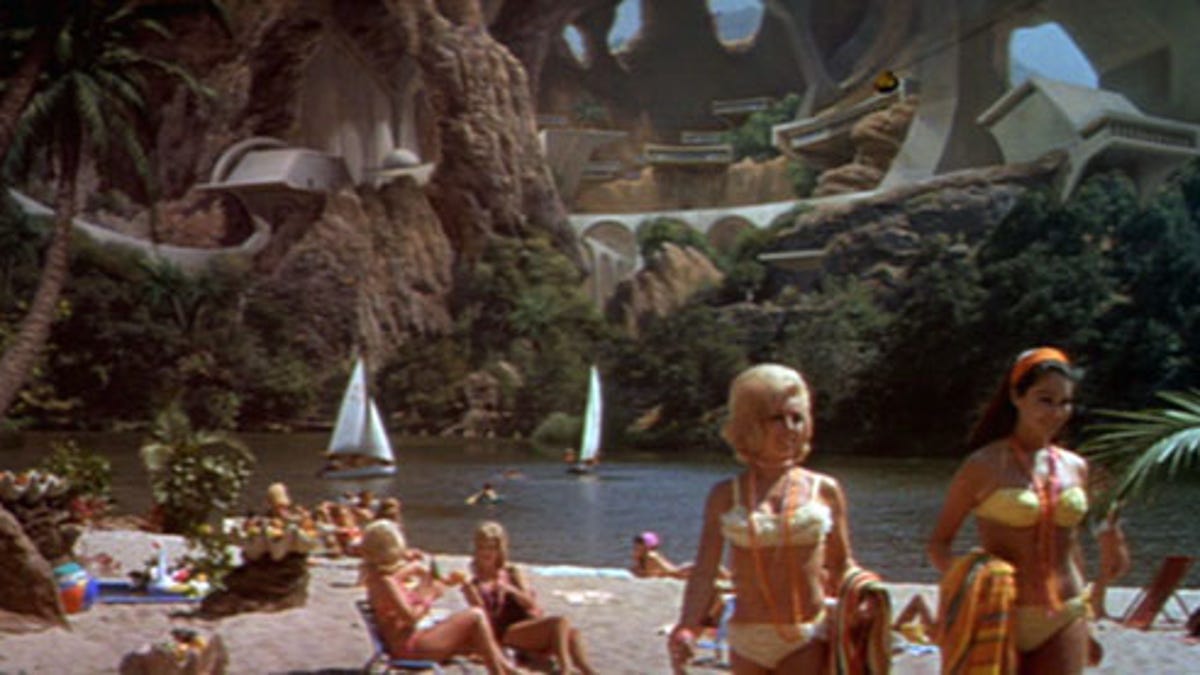 Coolest Image of Our Man Flint ... inside of Galaxy Island. |
|
|
|
Post by brutalis on Sept 19, 2019 17:12:25 GMT -5
I always felt like The President's Analyst works as a 3rd Flint movie in an odd and strange way. Anybody else?!?
|
|
|
|
Post by codystarbuck on Sept 19, 2019 17:33:11 GMT -5
I always felt like The President's Analyst works as a 3rd Flint movie in an odd and strange way. Anybody else?!? Definitely the same DNA. |
|




























